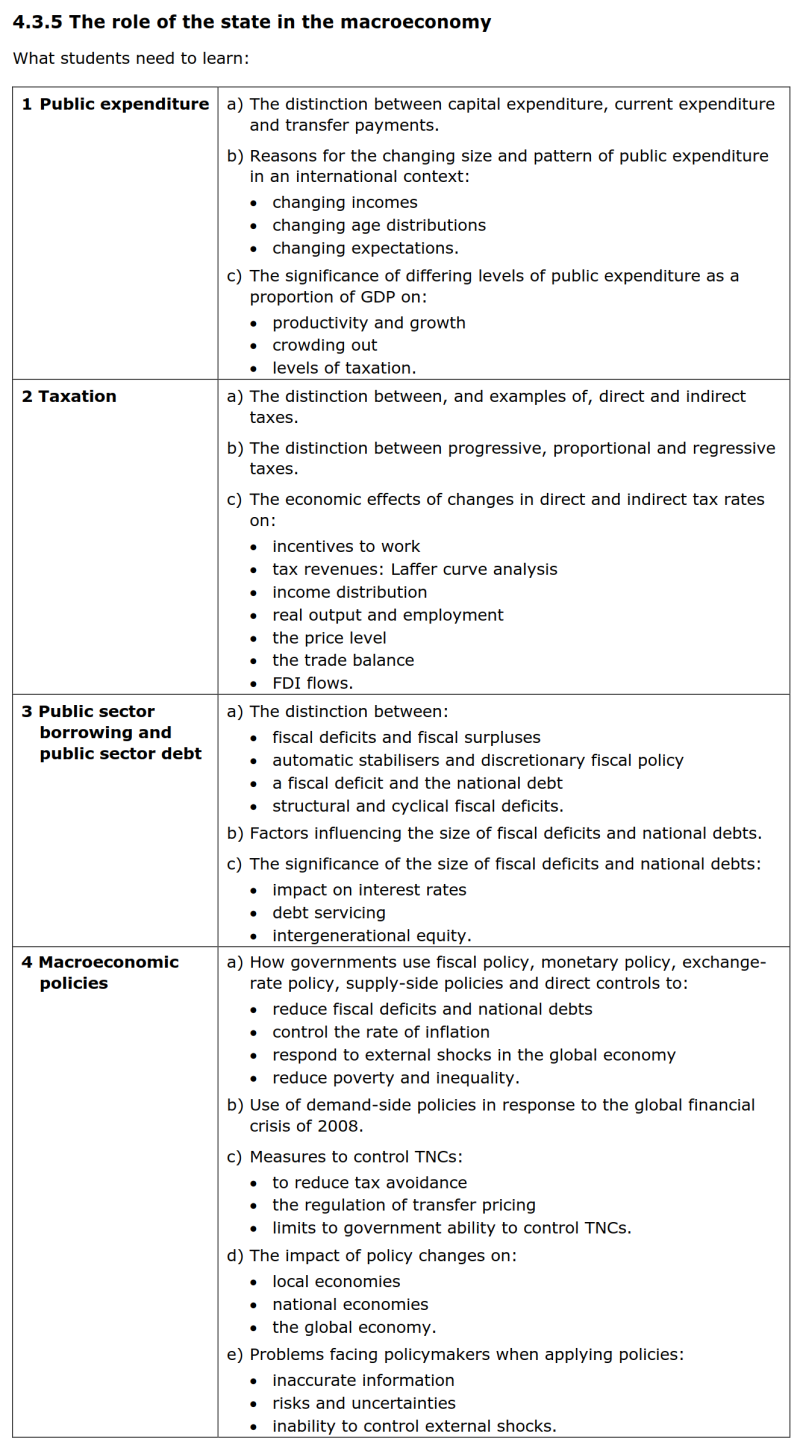Edexcel IAL U4 revision - Section 5 (2018)
如遇到公式加载异常,请刷新页面!
Section 5 The role of the state in the macroeconomy 国家在宏观经济中的作用
- 大纲要求
1. Public expenditure 公共支出
a) The distinction between capital expenditure, current expenditure and transfer payments. 资本支出、经常性支出与转移支付之间的区别
b) Reasons for the changing size and pattern of public expenditure in an international context: 国际背景下公共支出规模和模式发生变化的原因:
• changing incomes 收入变化
• changing age distributions 年龄分布的变化
• changing expectations. 预期情况的变化
c) The significance of differing levels of public expenditure as a proportion of GDP on: 不同水平的公共支出占GDP的比重在以下方面的影响:
• productivity and growth 生产率和经济增长
• crowding out 挤出效应
• levels of taxation. 税收水平
2. Taxation 税收
a) The distinction between, and examples of, direct and indirect taxes. 直接税与间接税之间的区别及相应的例子
b) The distinction between progressive, proportional and regressive taxes. 累进税、比例税与累退税之间的区别
c) The economic effects of changes in direct and indirect tax rates on: 直接税率与间接税率的变化对以下方面的经济影响:
• incentives to work 工作积极性
• tax revenues: Laffer curve analysis 税收:拉弗曲线分析
• income distribution 收入分配
• real output and employment 实际产出与就业
• the price level 价格水平
• the trade balance 贸易差额
• FDI flows. 外国直接投资的流动
3. Public sector borrowing and public sector debt 公共部门借贷与公共部门债务
a) The distinction between: 下列概念之间的区别:
• fiscal deficits and fiscal surpluses 财政赤字与财政盈余
• automatic stabilisers and discretionary fiscal policy 自动稳定器与相机财政政策
• a fiscal deficit and the national debt 财政赤字与国家债务
• structural and cyclical fiscal deficits. 结构性财政赤字与周期性财政赤字
b) Factors influencing the size of fiscal deficits and national debts.财政赤字和国债规模的影响因素
c) The significance of the size of fiscal deficits and national debts: 财政赤字和国债规模的影响:
• impact on interest rates 对利率的影响
• debt servicing 偿债
• intergenerational equity. 代际公平
4. Macroeconomic policies 宏观经济政策
a) How governments use fiscal policy, monetary policy, exchange-rate policy, supply-side policies and direct controls to: 政府如何利用财政政策、货币政策、汇率政策、供给侧政策和直接控制来完成以下目的:
• reduce fiscal deficits and national debts 减少财政赤字与国债
• control the rate of inflation 控制通胀率
• respond to external shocks in the global economy 应对全球经济的外部冲击
• reduce poverty and inequality. 减少贫困与不平等
b) Use of demand-side policies in response to the global financial crisis of 2008. 使用需求侧政策应对2008年全球金融危机
c) Measures to control TNCs: 控制跨国公司的措施:
• to reduce tax avoidance 减少避税
• the regulation of transfer pricing 对转让定价的监管
• limits to government ability to control TNCs. 限制政府控制跨国公司的能力
d) The impact of policy changes on: 政策变化对以下方面的影响:
• local economies 当地经济
• national economies 本国经济
• the global economy. 全球经济
e) Problems facing policymakers when applying policies: 政策制定者在实施政策时面临的问题:
• inaccurate information 信息不准确
• risks and uncertainties 风险与不确定性
• inability to control external shocks. 无法控制外部冲击
